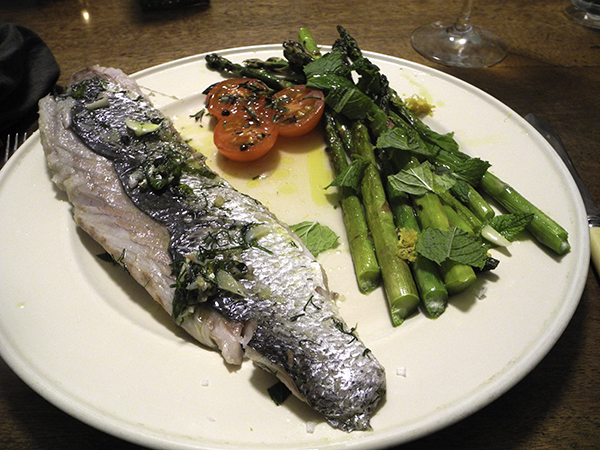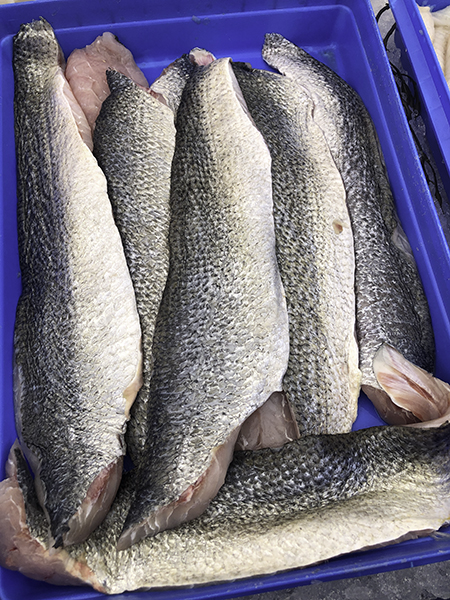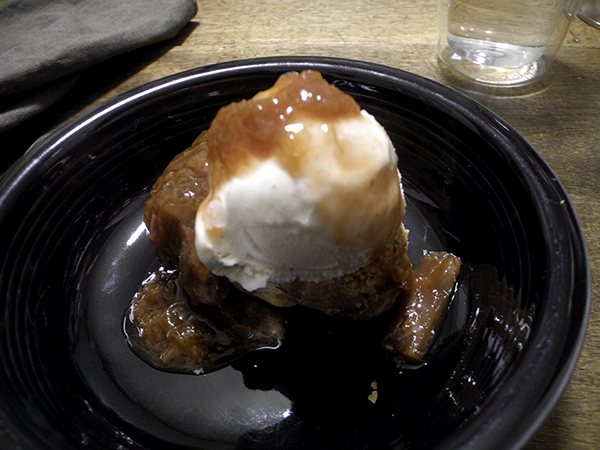
Squeteague (aka ‘Weakfish’ or Sea/Ocean Trout). I’ve written it before: We love this fish.
It’s a noble fish, but it’s not a trout. It’s generally marketed as ‘ocean trout’, I suppose because ‘weakfish’ doesn’t present a positive image. In fact the ‘weak’ part is only because the fish’s jaw tears apart easily when it is hooked (ouch), meaning it can more easily escape from an angler, the people who pass out the names, sometimes with less than fairness.
I seem to have prepared it 4 or 5 times, in several very different sizes. I’ve come to call it Squeteague, (except when I have to squeeze a name into a headline) mostly because of my fondness for coastal New England and its Narragansett heritage in its south [in the Narragansett language: pesukwiteag, meaning ‘they give glue’, because glue is made from them (or was at one time)].

- two 10-ounce squeteauge fillets (larger than our usual portions, but they don’t come to order) from American Seafood Company, marinated for a little over half an hour on the counter in a mix of a tablespoon or more of Whole Foods Market house Portuguese olive oil, 2 or 3 sliced spring garlic cloves from Lani’s Farm, and only 2 herbs this time (I’ve used up to 11), chopped dill from Stokes Farm and a smaller amount of chopped lovage from Keith’s Farm, after which the fillets were drained, sautéed or fried for almost 3 minutes inside a oil coated tin-lined heavy oval copper pan which had been pre-heated to medium-hot (enough oil to protect the tin lining while the pan heated up), skin-slide down first, then turned and cooked for another minute or 2, arranged on the plates, the juices, mixed in the pan with some of the marinade, drizzled on top
- three Backyard Farms Maine ‘cocktail tomatoes’ from Whole Foods Market, halved, their cut sides sprinkled with salt and pepper, heated inside an antique enameled cast iron porringer, turning once, arranged on the plates, sprinkled with chopped winter savory from Keith’s Farm and drizzled with the juices that remained in the porringer
- less than a pound of medium thickness asparagus (before trimming), 20 altogether, a mix bunch from Hoeffner Farms and John D. Madura Farms, their bottoms snapped off at the point where they easily break, rolled in a tablespoon of butter and less than a tablespoon of olive oil inside a heated large enameled rectangular cast iron pan, then sautéed over medium high heat while frequently rolling or turning them until they were beginning to brown (about 15 minutes), finished with a sprinkling of local sea salt from P.E. & D.D. Seafood and freshly-ground black pepper, sprinkled with zest from most of an entire Whole Foods Market organic lemon and some chopped furry spearmint from Space on Ryder Farm
- the wine was a delightful and extraordinary original from New York (Hudson River) orange, using traminette grapes, the unfined and unfiltered ‘Luca’ Skin Contact Traminette, 2017, that we had bought directly from the vintner
There was a sweet.

- one halved quite brilliant treat, a ‘shortcake’ from Lost Bread Co., their last ‘hominy biscuit’ at the stand that day (the ingredients are organic bread flour, butter, milk, purple corn, wheat , baking powder, baking soda, slaked lime, sea salt, sugar), topped with dollops of Talenti Madagascar Vanilla Gelato from Whole Foods, and drizzled with ambrosia: a homemade rhubarb-cardamon seed-star anise compote made with tiny (1/3 to 1/2-inch thick) early (late winter?) rhubarb stems from Hoeffner Farms
- the wine was Blandy’s 5 year old Bual Madeira
- the music throughout the meal was an album of gorgeous trecento music by the blind composer Francesco Landini, ‘L’Occhio del Cor’, performed by La Reverdie under the direction of Christophe Deslignes